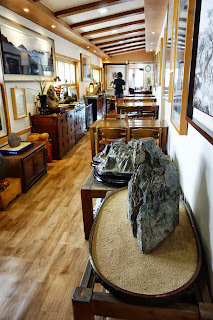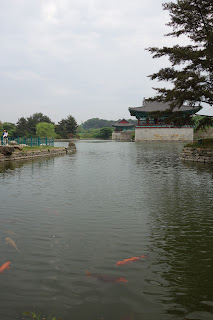Saturday
We got up early Saturday morning (truth be told, I got a terrible nights sleep because a noisy family arrived around midnight and the owner was busy clanging and banging pots and pans in the kitchen from around 6am) and caught the bus back into Gyeongju City (about 30minutes away). Just opposite the bus stop was Gyeongju Expo, home of Gyeongju Tower. I don't know any more than that because they wanted 7000 won just to go in. No thanks.
It was a nice day (and we were unsure what bus to catch) so we walked through the city to where we would spend the night. We kept walking and before we knew it we were on the outskirts of the city walking through rice fields. Gyeongju is notoriously difficult to develop because of all the historical artifacts in the area. You can't dig a hole in your garden without uncovering an old axe head or something.
Rice in trays ready for planting in the field. Further down I have some pictures of the machine they use to plan the rice.
A railway crossing
and the railway line.
Rice field on the left.
Rice field on the right.
Finally, we arrived. It was getting hot, so we were happy to take our shoes off and drop our bags in our room.
Our room had it's own private balcony at the rear of the building on the second floor. You can see another rice field (unplanted) in the background.
And here is our room. Much better than last night.
The owner was kind enough to let us borrow a couple of his bikes (for FREE) so we started heading back into town to see some of the sites.
First stop was was the tomb of King Sinmun (reigned from 681 to 692) and was the 31st ruler of the Silla Kingdom. He was the eldest son of King Munmu who unified the Three Kingdoms of Korea. The round eathern mound is 29 meters in diameter and 7.6 meters high.
We kept riding and passed a freshly planted rice field....
and the machine they were using to plant the rice. It looks a bit like a quad bike, but has some funky wheels and what I would describe as something like a sewing machine on the back that puts the plants in the ground. I have more pictures and a video further down.
As I said before, there are historical artifacts everywhere here in Gyeongju. Pictured here is some kind of stone turtle which I think formed the base of a pagoda. It is just sitting in the middle of a paddock and the farmers have to work around it.
Here is the tomb of Queen Seondeok (ruled from 632 to 647). It's diameter is 24 meters and height is 6.8 meters. The base of the mound was built with stones to protect the tomb. Queen Seondeok was the first queen of the Silla Kingdom. She is credited with the construction of many monumental buildings such as the Bunhwang Temple, the huge ninestory wooden pagoda of Hwangnyong Temple, and the astronomical observatory. It was during her reign of 16 years that the groundwork was laid for the unification of the Three Kingdoms of Korea. The Koreans have made a TV series about her.
And this is the view from the mountain. Rice fields everywhere.
A big noisy train.
We stopped for lunch at this restaurant which Jihyeon had seen on TV.
We ordered lunch (it was a little expensive at 25,000 won per person) and waited for the food.
As is the style in Korea, they bring out many small side dishes. As you consume the dishes they bring out more food. Below is the series of photos I took of the different things they brought out.
With full stomachs we continued on our journey (past more rice fields).
Here is the observatory (the oldest astronomical observatory in East Asia) that Queen Seondeok built. I read all the information I could find about it, but I still don't understand what was the point of it. It seems to just be a tower where astronomers could go to look at the stars. Other than being a dedicated place for them to do their work, I don't understand what it was meant to do. They could have stood on the ground and achieved the same results. The construction of the tower was meant to be quite advanced for its time. To build it, as they added each of the stone layers they would build the soil up around the tower so the top of the stones was at ground level, making it easy to add the next layer. Once finished they removed the soil from around the tower. It is 5.17 meters in diameter and 9.4 meters in height.
I had to take a toilet break so left my camera with Jihyeon. I found this picture when I got home. What's wrong?
As we rode through the city we passed the foundations of an old temple (pictured in the fore ground, they look like round stepping stones) and in the distance you can see the earthen mounds marking more tombs.
This forest is located between Cheomseongdae and Wolseong and is reputed for the birthplace of Gim Al-ji, the legendary founder of the Gyeongju Gim clan. The legend goes "A man called Hogong heard a rooster crying in the forest. Coming near to the woods, he saw a golden casket dangling on a branch of the tree. Hearing the report from Hogong, King Talhae went to the forest and pulled it down to find a male child inside the casket. So the child was given its name Gim and name Al-ji. Since then, the original name of the forest, Sirim or Gurim, was changed to Gyerim". Gim (also spelled Kim) is the most common family name in Korea. There are many Gim (or Kim) clans, but Gyeongju clan remains the biggest. In the 2000 census, more than 1.7 million Korean citizens claimed to be Gyeongju Kims.
Now, I am a foreigner in Korea and I don't always understand Korean reasoning but I am pretty sure CLIMBING SOMEONES TOMB AND SLIDING DOWN IT IS DISRESPECTFUL!!!! I was kind of shocked to see a Korean family (children and parents) not having a care in the world about treating it like a playground.
This is the head residence of the Gyeongju Choe clan. Built around 1700, The original residence is said to have been an immense mansion of 99kan (that is, the maximum space allowed for the house of common people during the Joseon period; 1kan corresponds to the space between 2 pillars). Part of it was destroyed by fire, but much of it is still intact. Without going into too much detail, in the 20th century Choe Jun donated all of his wealth (after the liberation of Korea in 1945) for the foundation of two institutions of higher learning, Gyerim College and Daegu College, which later combined to become Yeungnam University. He also was a renowned freedom fighter in the struggle against Japanese imperialism (1910-1945) and at one point spent hard time in a Japanese prison.
There were still people living in many of the rooms. I wonder how they feel about the steady stream of tourists.
Riding bikes together. ^^
This is an ice storage room (Seokbinggo), built during the reign of Yeongjo (1694-1776), the 21st king of the Joseon dynasty. It is 19m long, 6m wide and 5.45m high.
Some giant gold fish (I kid you not, some were about 40cm long). I threw some grass into the water and watched them all gulp it up with their giant goldfish mouths. I had a gold fish when I was a kid. His name was Bunkie and he was about 15cm long.
Some more rice fields and the funky contraption planting them.
This pagoda was built in 634 and made of andesite (a type of volcanic rock) cut like brick. Historians believe this pagoda was originally 7 or 9 stories high (based on the number of bricks found at the site) but when the Japanese rebuilt it (that was nice of them) they only made it 3 stories high. There are four stone lions (one on each corner) to protect it.
A small temple....
which houses a Buddha.
In the foreground is a well named Hoguknyongbyeoneojeong (I am not kidding, that is its full name)
A water lily flowering. All around many of the historical sites are huge ponds filled with water lilies which are meant to be quite spectacular come August/September (pictures here, here and here).
Hmm, what is this? Turns out it is a flag pole (Dangganjiju) and were erected during the unified Silla period. The two stone pillars were used to hoist flags during Buddhist ceremonies and are 360cm tall.
Next stop was Donggung Palace and Wolji Pond. It was destroyed at some point (I think by fire) but was discovered during excavation and dredging work conducted in 1975. Since then parts of it have been rebuilt. More giant goldfish in the picture below.
Below is a scale model of what it would have looked like 1300 years ago.
We rode back to our accommodation and started to prepare dinner. The owner of this place was absolutely great. While we were out sight seeing during the day, he went to the supermarket and bought some food for us to cook. I am busy washing some lettuce for Samgyeopsal.
And here I am busy cooking the meat on the back veranda of our room.
Once we finished we had to put the fire out. Jihyeon got a kick out of dripping water onto the fire. Small things.....
It was raining on Sunday so we slept in and headed back to the KTX station around lunch time. The awesome owner of the accommodation offered to drive is all the way into town, saving us about an hour of walking/catching the bus. Once in town we caught the bus over to the other side of town where the KTX station is located. The station is huge and looks funny stuck out in the middle of nowhere. Gyeongju is a hot tourist area for Korea so the spent a lot of money building a really nice station.
The roof reminds me of Incheon International Airport.
Weekend over. It was good to get back home and rest.


































































No comments:
Post a Comment